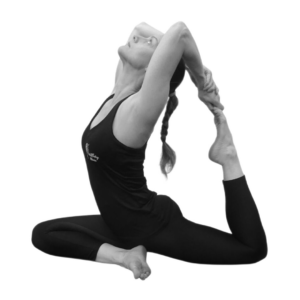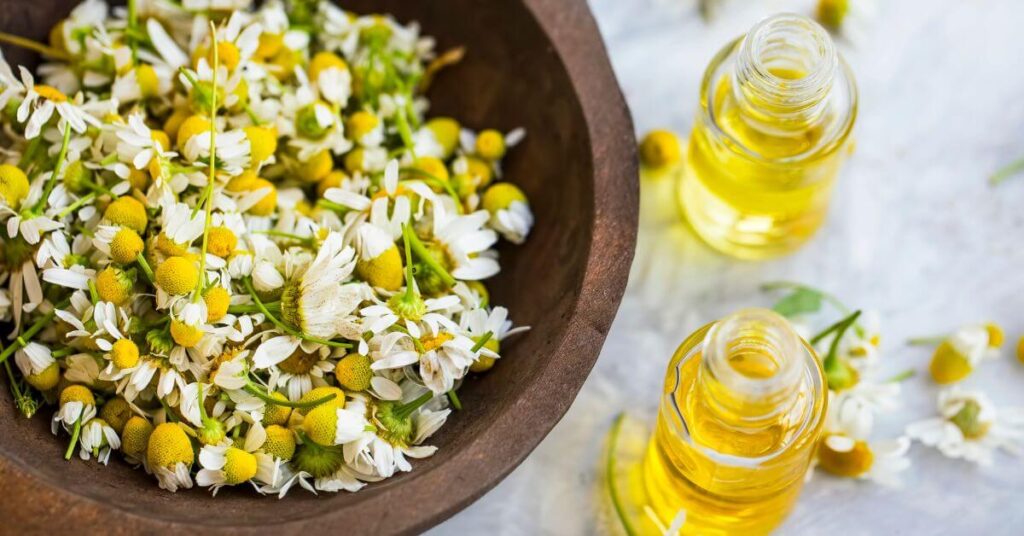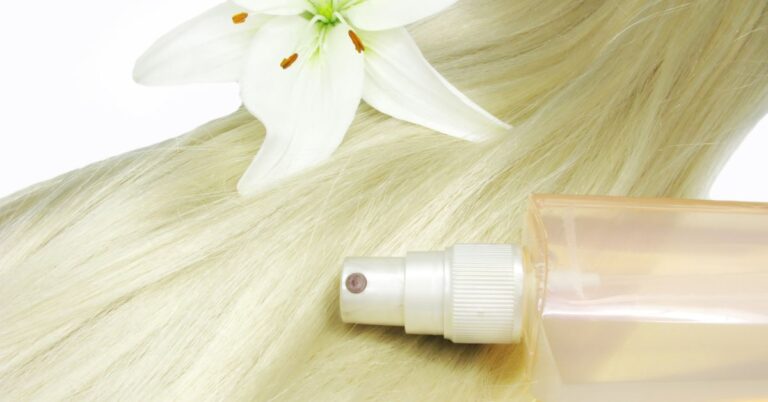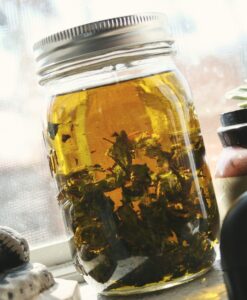
Founder of Wellbeing Winnie, Author of 'You Body Is Listening'

Crafting your own hair oil, where do we start?
The adage “As within, so without” symbolises the intricate relationship between the inner and outer worlds. It posits that our inner state, be it positive or negative, finds reflection in our external experiences and circumstances (obviously this includes your hair). This ancient wisdom, embraced by various philosophical and spiritual traditions, encourages introspective self-reflection and mindful, intentional living.
The principle of inner well-being manifesting as external health is fundamental in Ayurveda, Herbalism and holistic healing practises, especially when considering the physical form. Essentially, a harmonious inner state, encompassing mental, physical, and emotional health, reflects visually in the outer world and one’s physical appearance.
I discovered a passion for helping others through herbalism, holistic therapies, and yoga in a former life as a hairdresser. Despite my enjoyment of the profession. My realisation that I couldn’t assist people with chronic health or hair issues motivated me to pursue these fields of study.
Before embarking on hair oil treatments, it’s crucial to introspect and address the following questions:
By reflecting on these factors and striking a balance between hair treatments and understanding the causes of your hair concerns, you can develop a more informed approach to achieving healthy, beautiful hair.
Both Ayurveda and Herbalism, which are ancient systems of medicine, hold that hair )and the rest of the body) as being composed of the five elements: earth, water, fire, air, and ether.
These elements are present in varying proportions, resulting in different hair types. Individuals with thick, coarse hair generally have a predominance of earth and water elements, while fine, thin hair typically indicates a greater proportion of air and ether elements.
The harmonious balance of these elements determines the health and appearance of the hair. When the elements are in equilibrium, the hair remains healthy, lustrous, and robust. Conversely, an imbalance can lead to a range of hair concerns, such as dryness, brittleness, and an increased susceptibility to breakage.
To maintain healthy hair, Ayurveda emphasises the importance of balancing the elements through various practices. This can include adopting a diet rich in essential nutrients, incorporating herbal remedies and oils into hair care routines, and engaging in regular self-care practices like meditation and yoga. By addressing the underlying elemental imbalances, Ayurveda offers a holistic approach to promoting healthy, beautiful hair.
Methods to promote Equilibrium with the hair & Scalp
Practitioners that employ these age-old techniques engage in a variety of methods to promote equilibrium in the hair and scalp’s elements.
These techniques include:
- Herbal remedies: Herbs are used to help balance the elements in the hair and scalp. Some commonly used herbs for hair care include amla, bhringraj, and shikakai.
- Massage: Massage helps to improve circulation to the scalp, which can help to promote hair growth. It also helps to relax the mind and body, which can reduce stress-related hair loss.
- Diet: Holistic practitioners believe that diet plays an important role in hair health. They recommend a diet that is rich in fruits, vegetables, and whole grains. They also recommend avoiding processed foods, sugary drinks, and excessive caffeine.
- Lifestyle: Practitioners also believe that lifestyle factors such as stress, lack of sleep, and excessive exposure to the sun can damage the hair. They recommend getting regular exercise, getting enough sleep, and protecting the hair from the sun.

Understanding the hair growth cycle is crucial in comprehending the reasons for hair health and The hair growth cycle consists of three distinct phases: Anagen (growth), Catagen (transition), and Telogen (resting). After the Telogen phase, the hair follicle typically re-enters the Anagen phase, beginning a new growth cycle. During the Anagen phase, the hair follicle produces new hair cells, pushing the older hair shaft out of the follicle and up through the scalp.
However, sometimes the hair follicle may fail to re-enter the Anagen phase due to genetics, hormonal changes, or certain medical conditions. This results in the hair follicle losing its nutrient supply and ceasing hair growth, leading to prematurely stopped growth. The affected hair shaft becomes thinner, shorter, or falls out, causing hair loss.
Factors Contributing to Hair Loss:
- Genetics and Hormones:
- Genetic predisposition plays a significant role in hair loss, influencing factors such as hair thickness, texture, and growth patterns.
- Hormonal imbalances, particularly in relation to androgens like testosterone, can contribute to hair loss.
- Age:
- With advancing age, natural hair growth slows down, and the hair follicles become weaker, leading to thinning hair and increased hair loss.
- Medical Conditions:
- Certain medical conditions, such as thyroid disorders, alopecia areata, and cancer treatments like chemotherapy, can cause temporary or permanent hair loss.
- Lifestyle Factors:
- Poor diet, nutritional deficiencies, excessive stress, and certain medications can contribute to hair loss.
- Styling habits involving heat styling tools, tight hairstyles, and chemical treatments can damage the hair and lead to breakage.
- Environmental Factors:
- Exposure to harsh weather conditions, UV radiation, and air pollution can damage the hair and scalp, contributing to hair loss.
Hair thinning and baldness can have various causes, including genetics, ageing, malnutrition, poor iron levels, and vitamin absorption issues. Alopecia, a common hair loss condition, is often triggered by stress. Additionally, hormonal factors can contribute to hair thinning and baldness. Thyroid function plays a role, particularly in women, while Dihydrotestosterone (DHT) is a crucial factor in hair growth in men. DHT is responsible for male facial and pubic hair development but can also contribute to the deterioration of scalp follicles, ultimately leading to hair loss.

Telogen effluvium is a type of non-scarring hair loss that is characterised by sudden and excessive shedding of resting hair strands. It can be acute or chronic. It happens when more than 15% of hair follicles enter the Telogen (resting) phase, which normally comprises about 15% of the hair on a healthy scalp. Stressors, hormonal changes, and medications can trigger Telogen effluvium.
A recent study conducted on 198 hospitalised COVID-19 patients found that nearly half of them experienced hair loss. The study participants included 79 males (39.9%) and 119 females (60.1%), with ages ranging from 18 to 85 years. The study attributed the increased incidence of hair loss to the psychological stress and extensive medication use associated with COVID-19.
Hair loss due to Telogen effluvium typically lasts around 3 to 6 months before starting to grow again. However, the time it takes for the total hair volume to return to normal depends on the length of the hair.

Are usually infusions of herbal compounds in water that are applied to the hair, either by soaking or spray the hair and scalp until the hair is saturated. depending on the strength of the tonic, the infusion is usually rinsed off the hair after a period of time (30 minutes – 1 hour after application).
But why?
Well quite simply they are frequently used in an attempt to stimulate and strengthen hair growth. Although the specific mechanisms by which they work remain unclear, some individuals report positive results while others observe no noticeable effects.
A common belief is that hair tonics stimulate the hair follicle and its blood supply to promote growth, but there is currently lack of scientific evidence to support this claim. To better understand the potential benefits of hair tonics, further research is needed to establish correlations between successful outcomes and other lifestyle factors such:
A little bit of history
English Physician Nicholas Culpeper’s (1616-1654) “The Systematisation of the Use of Herbals” played a pivotal role in the development of modern pharmaceuticals, serving as a foundational text in the field. The majority of the Culpers’ information and research originated from the field of herbalism.
Culper suggested two potential remedies for hair growth and reducing hair loss: applying linseed oil to the hair or consuming an infusion of sage water once daily. Additionally, the infused sage water can be applied to the hair for a short time before rinsing (as a tonic).
There does seem to be some evidence for his suggestion. Both linseed oil and sage contain Phytoestrogens which are plant-derived estrogen-like compounds that share a similar structure to 17β-estradiol, a primary female sex hormone. Recent research indicates that the appropriate level of phytoestrogens can contribute to improved hair growth, while excessive estrogen can lead to hair thinning.
Herbal Infusions To Include In A Tonic
Chamomile for Revitalized Hair (Learn more about chamomile here):
- Chamomile, renowned for its restorative properties, can revitalise sun-faded hair.
- It fortifies hair strands, preventing split ends.
- Chamomile has the ability to naturally lighten hair color.
- It restores radiance and adds shine, transforming dull locks into vibrant, healthy-looking hair
Nettle for Hair Loss Prevention:
- Nettle, a plant with a long history of medicinal use, is known for its role in addressing hair loss.
- For centuries, it has been used to prevent and treat hair loss effectively.
- Nettle’s abundance of sulphur and silica strengthens the hair shaft, enhancing overall hair health.
Apple Cider Vinegar for Dandruff and Scalp Health:
- Apple cider vinegar, with its natural antibacterial and antifungal properties, is often used as a hair rinse.
- It is effective in combating dandruff.
- Apple cider vinegar’s soothing qualities provide relief for itchy scalps and heightened scalp sensitivity.
Rosemary has been used by many to promote hair growth.
- In moderation – rosemary may benefit nerve tissue. The study revealed that carnosic acid, a bioactive compound found in the plant, has the potential to mend nerve and tissue damage. This remarkable ability to repair nerve endings could potentially extend to the nerves in the scalp, potentially promoting hair growth restoration.
Here is a guide to choosing the right essential oils based on your hair type:
—–Normal Hair:
- Eucalyptus
- Cedarwood
- Geranium
- Orange
- Lavender
- Rosemary
—–Oily Hair:
- Basil
- Bergamot
- Cedarwood
- Cypress
- Grapefruit
- Lavender
- Lemon
—–Dry Hair:
- Frankincense
- Geranium
- Lavender
- Palmarosa
- Rosemary
- Sandalwood
—–Damaged Hair:
- Lavender
- Frankincense
—–Fine Hair:
- Geranium
—–Dark Hair:
- Rosemary
- Thyme
—–Fair Hair:
- Roman Chamomile
—–Grey Hair:
- Sage
—–Frequently Washed Hair:
- Geranium
- Horsetail
- Lavender
- Rosemary
—–Thinning Hair:
- Basil
- Clary Sage
- Cypress
- Palmarosa
- Rosemary
- Thyme
- Cedarwood
—–Dandruff:
- Cedarwood
- Rosemary
- Sage
- Tea Tree
- Thyme
- Patchouli
Earth: Provides strength and thickness to the hair. An excess of earth can lead to thick, coarse hair that is prone to oiliness. A deficiency can result in thin, weak hair that lacks volume.
Some essential oils that help with this element (As you may have guessed these all have an earthy scent):
Vetiver, Clove, Ginger, Cinnamon, Black Pepper, Sandalwood, Camphor, Cedarwood, and Patchouli.
Water: Nourishes and hydrates the hair. Too much water can lead to limp, lifeless hair, while too little can cause dryness and brittleness.
Chamomile, Eucalyptus, Jasmine, Lemon, Myrrh, Rose, Ylang Yang
Fire: Promotes hair growth and pigmentation. An excess of fire can lead to premature greying and hair loss, while a deficiency can result in slow hair growth and a lack of shine.
Amber, Cinnamon, Spice, Ginger, Frangipani,
Air: Provides lightness and movement to the hair. Too much air can lead to dry, frizzy hair, while too little can make the hair heavy and flat.
Lavender, Lemongrass, Peppermint, Spearmint,, Lemon and Myrtle
Ether: Governs the overall health and vitality of the hair. An excess of ether can lead to dull, lifeless hair, while a deficiency can result in hair that is prone to breakage and split ends.
Cypress, Geranium, Lavender, Lemon, Neroli, and Ylang Ylang
Natural and Pure Ingredients: You have complete control over the ingredients used in your hair oil, ensuring they are natural and free from synthetic additives or harsh chemicals that could potentially damage your hair.
To ensure we make informed choices about the products we use, it’s crucial to understand their labels. This includes knowing the chemicals they contain and whether they’ve been tested on animals. By creating our own products, we gain complete control over the ingredients used. This eliminates any uncertainty and gives us peace of mind knowing exactly what we’re putting on our hair.
Customised for Your Hair Type: Your hair is unique, so a store-bought hair oil might not address your specific needs. Crafting your own allows you to cater to your hair type, whether it’s dry, curly, oily, or colour-treated.
Cost-effective: Making your hair oil is significantly more budget-friendly compared to purchasing ready-made products that may contain questionable ingredients.
Having long and thick hair, I’ve noticed that a small bottle of store-bought hair oil only lasts me for three washes. If I’m washing my hair three times a week, this can quickly become a costly routine.
Versatile Uses: Hair oil has multiple benefits beyond nourishing your scalp and strands. It can also be used as a styling agent to tame frizz or add shine, a deep conditioning treatment, or a split-end mender.
For hair oil we will need a ‘carrier’ or ‘base’ oil, These are oils used in high quantities to dilute essential oils before applying them to the skin. They contain high levels of fatty acids, which nourish the skin and hair.
They have several uses, including moisturising, reducing acne, promoting hair growth, and improving scars and wrinkles.
Before using any carrier oil, a patch test should be performed to check for allergies. The selection of carrier oil depends on skin type and desired results, with heavier oils like castor oil recommended for dry skin, and lighter oils like coconut oil suitable for oily skin.
Here are three carrier oils, listed from thickest to lightest:
Benefits of Castor Oil for Hair Care:
Benefits of Olive Oil for Hair Care:
Benefits of Coconut Oil for Hair Care:

As you prepare your mix, consider whether you will be solely using essential oils or infusing dried herbs as well.
The ancient method of infusing herbs into oil by slow steeping transfers the therapeutic qualities, aroma, and hue from the herbs to the oil. During the infusion process, beneficial compounds, fatty acids, and natural essential oils are extracted from the herbs and absorbed by the carrier oil. This traditional form of medicine making harnesses the therapeutic potential of herbs for various healing purposes.
As an herbalist practitioner, I prioritise completing this step before adding the essential oils. There are two infusion methods to consider:
Make your Infusion:
Create your Tonic
When dealing with dandruff and hair loss:
Adding shine, soothing scalp and encouraging hair growth:
Crafting your hair oil or tonic is a rewarding and beneficial venture that allows you to nourish your hair with natural, customised ingredients. By following the steps outlined in this blog post, you can create your own hair oil tailored to your unique needs. Experiment with different carriers and essential oils to discover the perfect combination for your luscious locks.
Remember, consistency is key – regular use of your homemade hair oil will gradually reveal its transformative effects. Embrace the journey towards healthier, more beautiful hair with your very own DIY hair oil.
Warm a small amount of oil in your hands and massage it into your scalp and hair, covering the strands from root to tip.
Wrap your hair in a warm towel or plastic wrap and leave it on for 30 minutes to an hour.
Wash and condition your hair as usual.
Apply a dime-sized amount of oil to damp hair, focusing on the ends to prevent split ends.
Style your hair as desired.
Massage a few drops of oil into your scalp before bed to soothe dryness, itching, or dandruff.
Leave it on overnight and wash your hair in the morning.
Use a small amount of oil to tame flyaway hairs, define curls, or add shine to your hair.
Apply it to dry or damp hair as needed.
Crafting your hair oil or tonic is a rewarding and beneficial venture that allows you to nourish your hair with natural, customised ingredients. By following the steps outlined in this blog post, you can create your own hair oil tailored to your unique needs. Experiment with different carriers and essential oils to discover the perfect combination for your luscious locks.
Remember, consistency is key – regular use of your homemade hair oil will gradually reveal its transformative effects. Embrace the journey towards healthier, more beautiful hair with your very own DIY hair oil.
Teas & Hot Drinks
You can read more about this wonderful herb and others with our Treetop Teahouse ebook.
Treetop Teahouse Menu Ebook – available for download from our store here
£5.00£3.00Ebook – Available in English and Italian
Each page will guide you through the preparation of a handful of herbal teas and includes the reputed benefits as well as contraindications.
Herbal alternatives can be very powerful. Some of the suggested teas can interfere with certain medications. Please consult your medical practitioner before starting any new healthier alternatives.
Only 14.99 per month
We are truly passionate about what we do. By offering online yoga/wellness classes and tutorials, we can be there to help you whenever and wherever you are. All our online tutorials are designed to help you understand safe movement and correct alignment. We know yoga and meditation are incredible tools for promoting health and happiness.